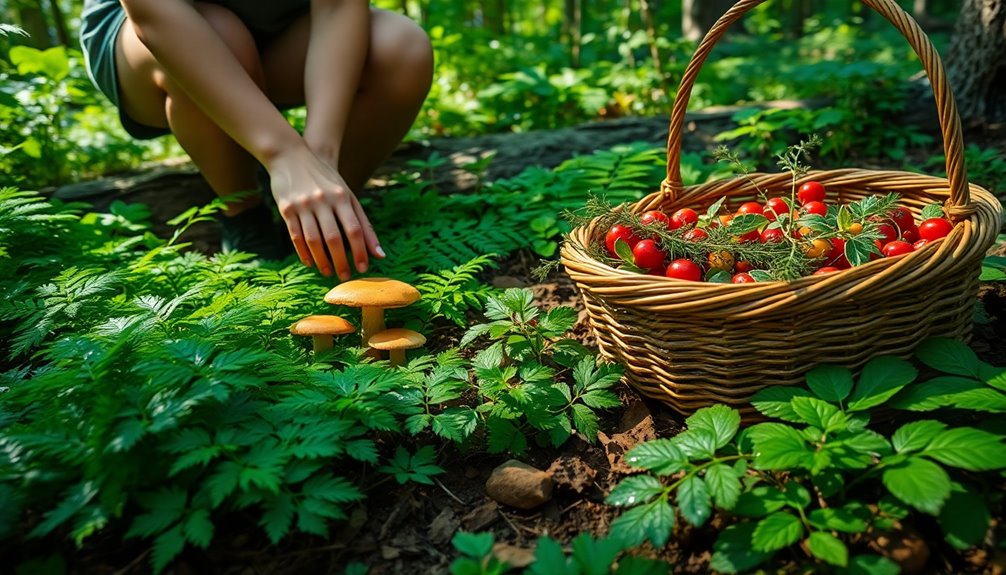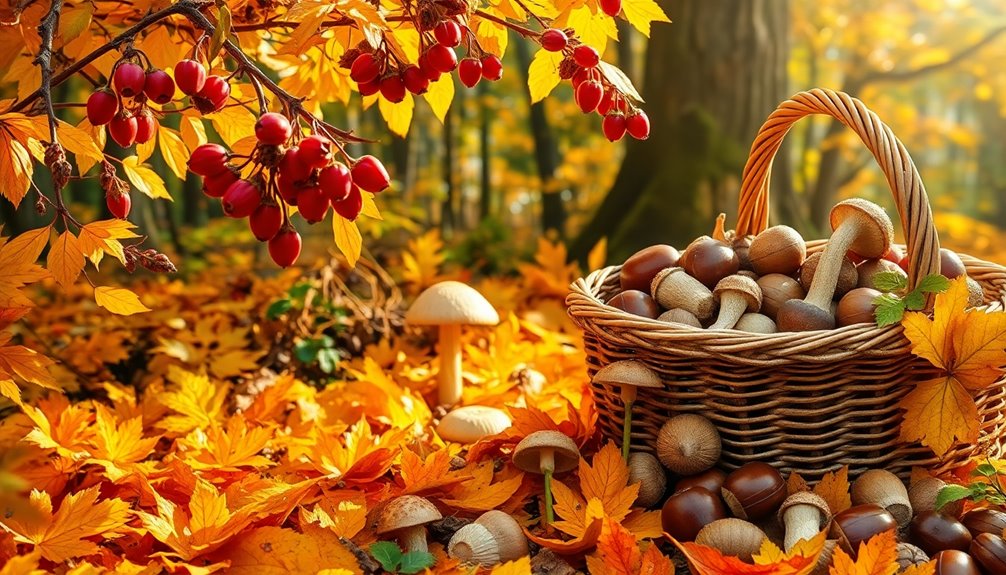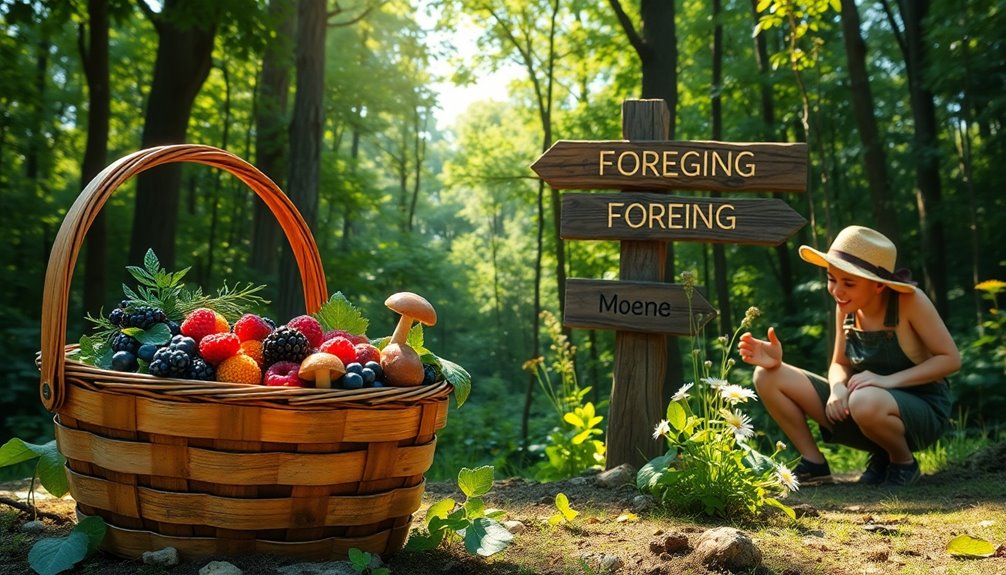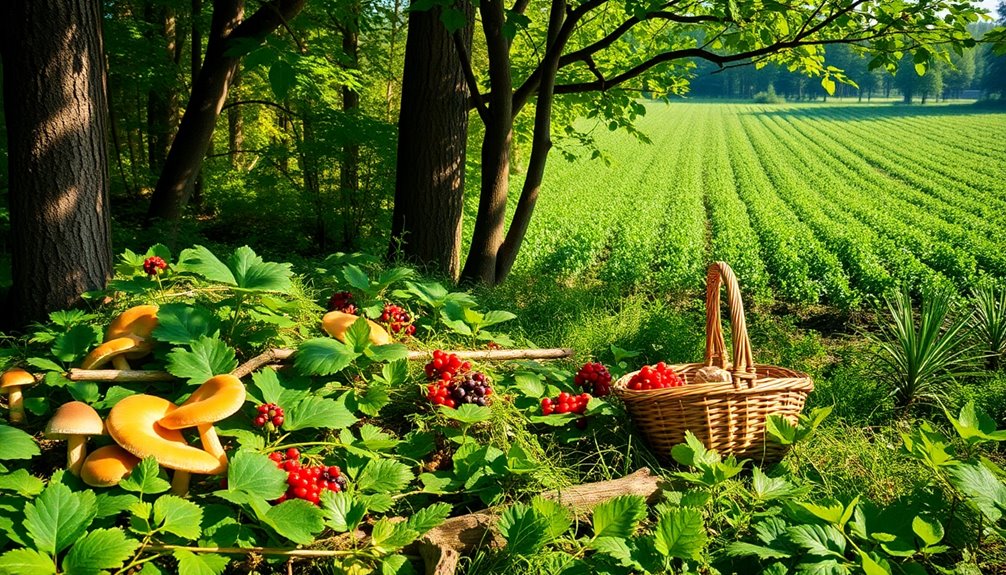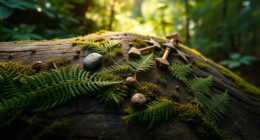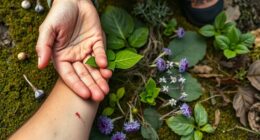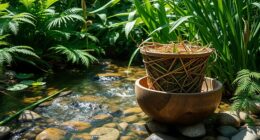Foraging is the ancient practice of searching for and gathering wild food from nature, like fruits, nuts, and mushrooms. It's not just about finding something to eat; it connects you with your environment and community. For thousands of years, this skill was essential for survival, and many indigenous cultures still preserve these traditions today. Foraging promotes sustainable food practices, enriches your diet, and enhances your physical health. Plus, it's a fantastic way to engage with your local ecosystem. If you're curious about how these techniques can shape your culinary adventures, there's much more to explore.
Key Takeaways
- Foraging is the practice of searching for and gathering wild food resources, including plants and animals, connecting individuals with nature.
- It has been a vital food acquisition method for thousands of years, predating agriculture and shaping human diets and lifestyles.
- Foraging enhances nutrition and food security by providing access to diverse, seasonal, and organic food sources.
- It embodies traditional ecological knowledge, fostering sustainability and preserving cultural heritage within communities.
- Modern culinary foraging promotes local, wild ingredients in dining, enriching culinary experiences and supporting sustainable food practices.
Definition of Foraging
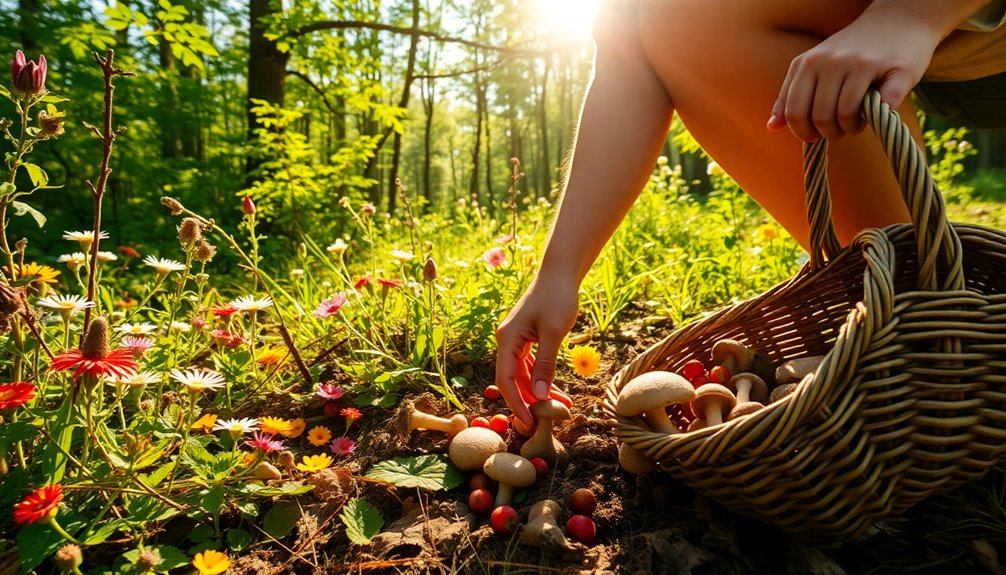
Foraging is the act of searching for and gathering wild food resources, including both plants and animals. This practice encompasses a wide variety of foraged foods, such as fruits, nuts, mushrooms, and even game. By engaging in foraging, you connect with nature and tap into a time-honored method of food acquisition.
The term isn't limited to just humans; it's relevant to animals as well, emphasizing the universal need for food across species. Foraging has been essential for human survival since prehistoric times, shaping diets and nutritional intake long before agriculture emerged.
Today, there's a growing interest in foraging driven by a desire for sustainable living and local food sourcing. Many people are now participating in educational workshops and community events that teach responsible foraging practices.
This not only helps you learn about the diverse wild food available but also promotes sustainable harvesting techniques to prevent resource depletion.
Historical Context and Evolution
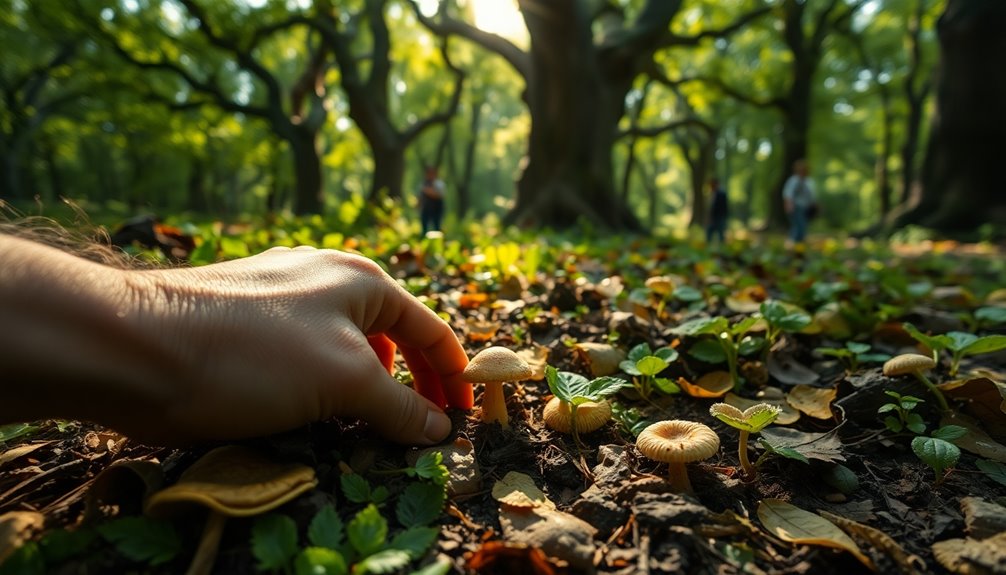
Understanding the historical context of foraging helps you appreciate its significance in human development. For thousands of years, foraging was essential for the survival of early human ancestors.
As societies evolved, the shift from foraging to agriculture around 10,000 years ago fundamentally changed diets and lifestyles.
Today, foraging has become more than just a survival skill; it reflects a rich history and cultural practices around the world.
Consider the following points:
- Foraging practices varied by region due to local climates and available resources.
- Diverse culinary practices emerged, showcasing the adaptability of human diets.
- Indigenous societies maintain foraging traditions, enhancing their ecological knowledge.
- The skills developed through foraging promoted social structures centered on communal food gathering.
- Moreover, understanding the foraging range of different species can provide insights into their ecological roles and the sustainability of harvesting practices.
With a growing interest in foraging, many people are reconnecting with these ancient practices.
This renewed focus not only honors historical roots but also emphasizes the importance of sustainable living.
Foraging in Nature
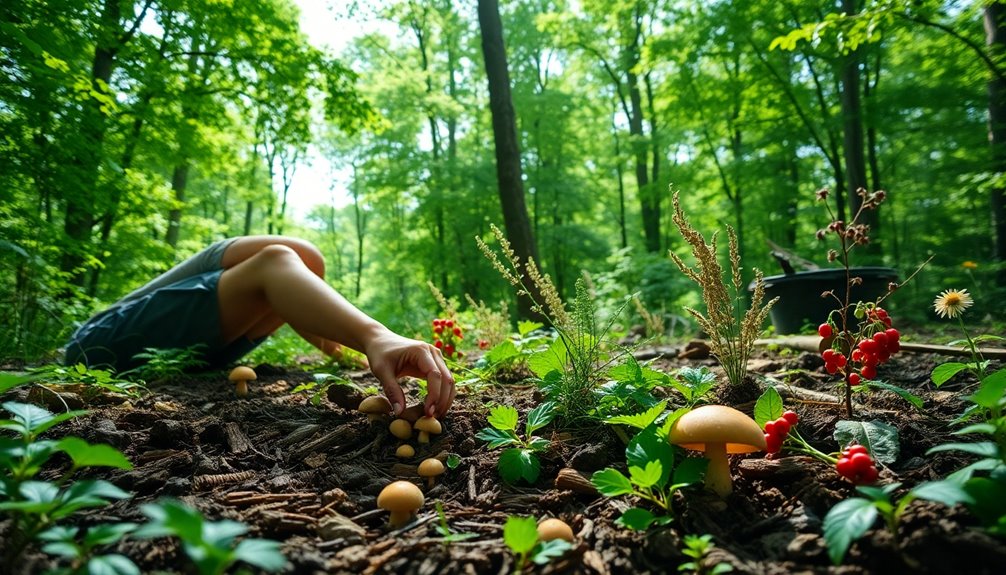
Exploring nature for wild food resources can be an exciting and rewarding experience. By foraging, you can discover a variety of fruits, nuts, mushrooms, and herbs that greatly enhance your diet's diversity and nutrition. Seasonal availability plays an important role; for example, you'll find many wild mushrooms in the fall, while berries are ripe in late summer. In regions like Michigan's state parks, foraging can lead to discovering over 300 species of edible plants.
Foraging promotes sustainability, encouraging you to utilize local and seasonal food sources. This practice not only reduces reliance on commercially produced items but also connects you to the rhythm of nature. Additionally, understanding the importance of ethical foraging practices will help ensure that you harvest responsibly and sustainably.
Remember, ethical foraging is essential. Follow guidelines that emphasize responsible harvesting—leave enough of a plant for regeneration and avoid overharvesting from vulnerable species.
As you explore this word of the day, consider joining community foraging events or workshops. These gatherings not only educate you about local ecosystems but also highlight the benefits of incorporating wild foods into your meals.
Cultural Significance of Foraging

Celebrating the cultural significance of foraging reveals how deeply intertwined it's with human history and identity. For many indigenous cultures, foraging isn't just a means of sourcing food; it's an essential tradition that carries ecological knowledge through generations.
You'll find that in various regions, communities honor this practice through events and festivals, showcasing local wild foods and preserving cultural heritage.
Foraging also plays an important role in food security, especially in areas with limited access to grocery stores. This connection to nature reinforces a sense of identity and belonging.
Here are some key aspects of foraging's cultural significance:
- It embodies traditional ecological knowledge that fosters sustainability.
- Community events celebrate local wild foods, linking people to their heritage.
- Foraging serves as a supplementary food source, enhancing food security.
- Educational programs teach traditional techniques, ensuring these practices endure.
- Additionally, foragers often develop sustainable practices that contribute to the health of local ecosystems.
Ultimately, foraging reminds us of our connection to the natural world, deepening our understanding of local ecosystems and encouraging biodiversity preservation.
Benefits of Foraging for Communities
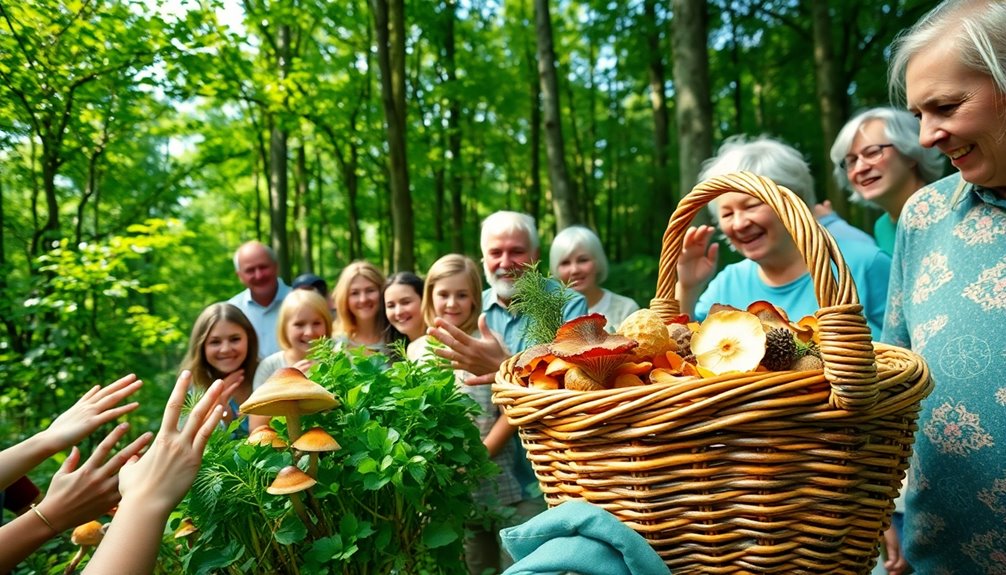
Foraging offers numerous benefits for communities, making it a valuable practice that goes beyond just gathering food. By foraging, you gain access to nutritious, organic food sources at little to no cost, promoting food security and reducing reliance on commercial food systems. This not only helps you but also strengthens the entire community.
Engaging in foraging activities encourages physical activity and outdoor engagement, contributing to improved health and wellness. As you source food locally, you enhance your community's economic resilience while reducing carbon footprints associated with food transportation.
Foraging also fosters social cohesion. You often find yourself gathering with others for educational workshops and foraging events, which strengthens relationships and enhances shared knowledge. These interactions build a sense of belonging and community spirit.
Additionally, the practice of foraging raises awareness about local biodiversity and environmental conservation. As you learn about native plants and sustainable practices, you become a steward of natural resources, encouraging others to do the same.
Fundamentally, foraging not only feeds you but also nourishes your community, fostering a healthier, more connected, and environmentally conscious society.
Modern Trends in Foraging
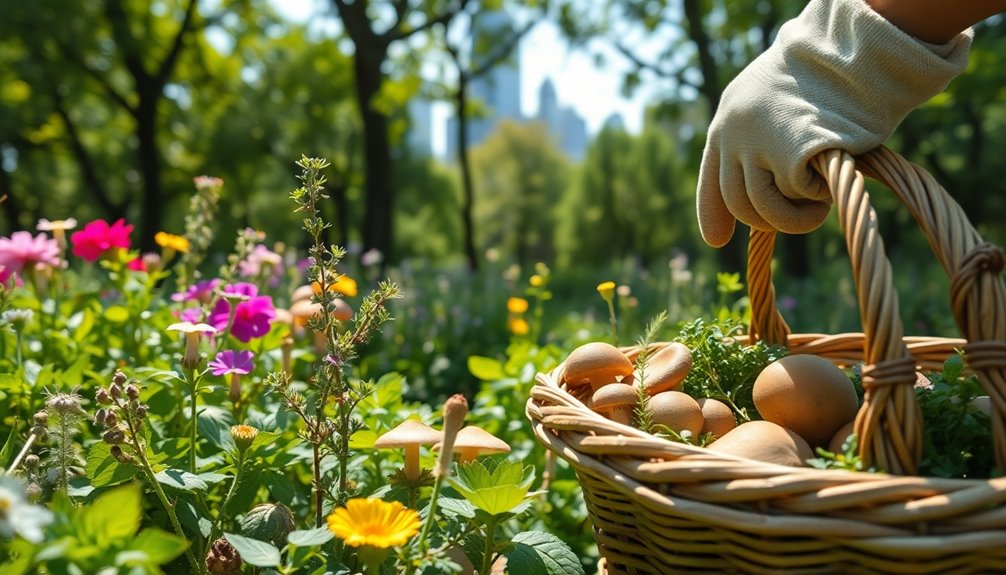
You're likely noticing a growing trend in culinary foraging, especially in urban areas where chefs are enthusiastic to incorporate wild, locally sourced ingredients into their dishes. This movement has encouraged many to explore efficient herbalism techniques to enhance their foraging skills.
As you explore this movement, you'll find vibrant foraging communities sharing knowledge and experiences through workshops and social media. This shift not only enhances your culinary adventures but also promotes sustainable food practices in your local economy. Additionally, this trend aligns with a broader appreciation for functional spaces that balance aesthetics and practicality in modern living.
Culinary Foraging Trends
A notable shift in the culinary world has emerged as chefs increasingly embrace foraging to discover unique, seasonal ingredients that elevate their dishes. This trend not only enhances menu diversity but also appeals to eco-conscious diners who value sustainability.
You may notice foraged ingredients making their way into mainstream grocery stores, with offerings like:
- Wild mushrooms
- Edible flowers
- Microgreens
- Sea vegetables
Restaurants are capitalizing on this movement by collaborating with local foragers and farmers, promoting a farm-to-table ethos and supporting local economies.
Social media plays a crucial role in this culinary foraging trend, enabling chefs and food enthusiasts to share their foraging experiences and creative recipes. You'll find stories behind the ingredients, which can deepen your appreciation for the food you consume.
Additionally, educational workshops on foraging techniques and safety are becoming increasingly popular. This rise reflects a growing desire to reconnect with nature and gain a better understanding of food sourcing. Understanding local laws can also help foragers navigate the complexities of sustainable harvesting.
As culinary foraging continues to thrive, you'll discover a richer dining experience that celebrates the beauty and variety of seasonal ingredients. So, why not explore this fascinating trend yourself?
Urban Foraging Communities
Reconnecting with nature has become a significant pursuit for many urban dwellers, leading to the rise of urban foraging communities. You might find these groups gathering in parks, vacant lots, and other green spaces to discover edible plants and mushrooms. Engaging with organized workshops, you'll learn to identify seasonal foraging techniques while sharing knowledge with fellow foragers.
Social media plays an essential role in this movement, connecting like-minded individuals who share their experiences, recipes, and locations of wild edibles. You can join online communities that foster collaboration and inspire you to explore your surroundings for nutritious food sources.
Research indicates that urban foraging can enhance food security, especially in areas lacking access to fresh produce. As awareness grows, local governments and organizations are beginning to recognize the benefits of urban foraging. They're implementing policies to promote sustainable harvesting practices and protect valuable foraging areas from overexploitation.
Foraging Techniques and Safety
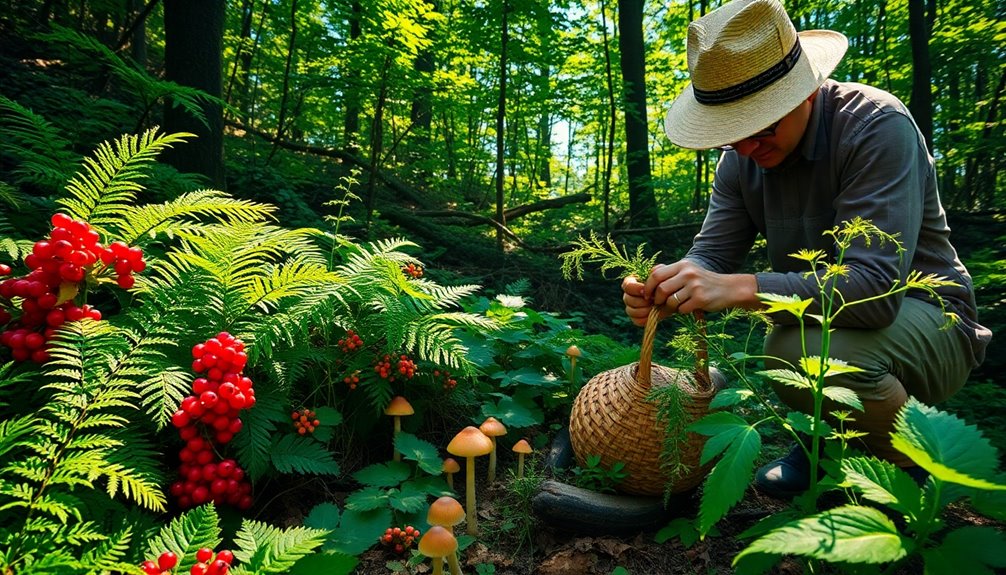
When you're foraging, knowing how to identify edible plants is key to a successful harvest.
Using the right gathering tools and techniques not only makes the process easier but also guarantees you respect nature.
Plus, practicing ethical foraging helps maintain the balance of the ecosystem for future generations.
Identifying Edible Plants
Identifying edible plants requires keen observation and a bit of practice. Start by learning key characteristics like leaf shape, flower color, and growth habitat. Many plants have toxic look-alikes, so being able to distinguish between them is essential for your safety.
Here are some tips to help you:
- Familiarize yourself with local flora using foraging guides or apps that provide detailed images and descriptions.
- Always forage in areas free from pollutants, such as urban settings or places treated with pesticides.
- Understand seasonal availability, as many edible plants thrive during specific times of the year.
- Practice ethical foraging by taking only what you need and leaving enough for wildlife and plant regeneration.
Gathering Tools and Techniques
Gathering tools and techniques are essential for successful foraging, ensuring you collect edible plants safely and sustainably. Understanding local flora and their seasonal availability is key to avoid toxic plants. Your toolkit should include the following:
| Tool | Purpose |
|---|---|
| Basket or Bag | For collecting items efficiently |
| Knife | For harvesting plants and fruits safely |
| Field Guide | To identify edible species accurately |
Safety is paramount. Familiarize yourself with the local ecosystem, noting potential hazards like poisonous plants or animals. Always double-check your identifications before consuming anything, as misidentification can have serious health consequences.
Consider joining foraging workshops or guided walks. These experiences enhance your skills and knowledge while offering hands-on practice in identifying and gathering wild foods. Plus, they foster a sense of community among fellow foragers.
Ethical Foraging Practices
Foraging requires a deep respect for the environment, which is why ethical foraging practices are so important. By following these guidelines, you can guarantee that your foraging activities contribute positively to the ecosystem rather than harming it.
- Know local regulations: Always adhere to local laws regarding wild plant and mushroom collection. This helps protect resources and ecosystems.
- Identify before you harvest: Make sure you can positively identify what you're foraging. Some plants are toxic or endangered, so it's essential to respect biodiversity and leave enough for wildlife.
- Practice sustainable harvesting: Take only a fraction of a plant or pick in ways that allow for regrowth. This helps maintain healthy populations of the species you're foraging.
- Be aware of seasons: Understand when specific plants are at their peak. Avoid foraging during vulnerable periods, like flowering or fruiting, to guarantee they can regenerate.
Incorporating these ethical practices into your foraging routine not only enhances your experience but also fosters a deeper connection with nature while guaranteeing that future generations can enjoy the bounty of the wild.
The Future of Foraging Practices
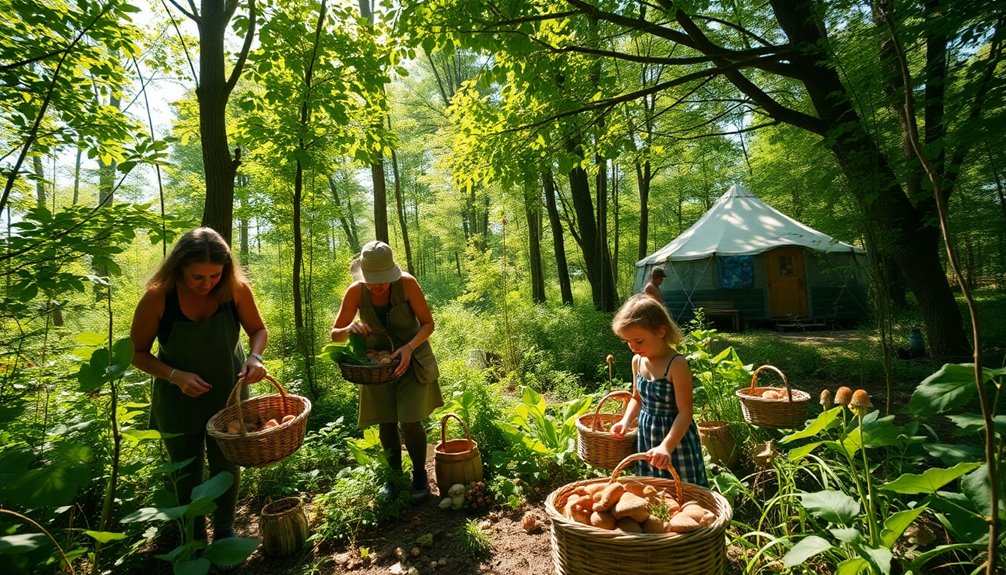
As the world leans towards sustainability, the future of foraging practices is looking brighter than ever.
You'll likely notice a surge in urban foraging workshops designed to teach responsible wild food gathering. These initiatives are making it easier for you to connect with nature and learn about edible plants in your area.
Technology is also playing a pivotal role. Foraging apps that identify edible plants and mushrooms are enhancing your foraging experience, making it safer and more accessible. With these tools, you can confidently explore your local environment.
Community engagement is expected to bolster local economies, as you and others seek unique, locally-sourced ingredients. This shift supports local foragers and farmers, fostering a sense of community.
Moreover, chefs are increasingly integrating foraged ingredients into their menus, appealing to your desire for sustainable dining options.
As awareness of environmental issues grows, foraging will likely promote biodiversity and conservation efforts. By adopting sustainable harvesting practices, you can help protect ecosystems and native species.
In this evolving landscape, foraging stands to enrich your culinary experiences while nurturing the planet. The future truly looks promising for this age-old practice. Additionally, understanding the importance of nutritional balance in foraged foods can enhance your health and survival skills.
Frequently Asked Questions
What Is the Meaning of the Word Foraging?
When you think about foraging, you're considering the act of searching for and gathering food from nature.
It involves picking wild plants, fruits, nuts, and even hunting or fishing. Foraging connects you to your environment and encourages a sustainable lifestyle.
As you explore, you not only find delicious edibles, but you also learn about biodiversity and responsible practices that help preserve these natural resources for future generations.
What Is the Meaning of Foraging?
When it comes to foraging, you're really digging into nature's pantry. Fundamentally, foraging means searching for and gathering wild food, like plants, fruits, and mushrooms.
It's not just about survival; it's also a way to connect with the environment and embrace local biodiversity. By foraging, you can discover new flavors and sustainable practices that enrich your diet while respecting nature.
What Is the Short Meaning of Foraging?
Foraging simply means searching for and gathering wild food resources, like plants, fruits, nuts, and mushrooms.
It's a natural way you can connect with your environment and find sustenance. Many people are rediscovering foraging today, driven by interests in sustainability and local food sourcing.
Just remember, practicing responsible foraging is essential to protect ecosystems and guarantee that nature's bounty remains abundant for future generations.
What Is Another Word for Foraging?
You might think foraging is just about finding food, but it's so much more.
Another word for foraging is "gathering." This term captures the essence of collecting not just food, but also herbs, mushrooms, and other natural resources.
You can also consider "scavenging," which emphasizes searching for edible items, or "wildcrafting," when you focus on wild plants and herbs for various uses.
Each term adds depth to your understanding of this enriching practice.
Conclusion
In the grand tapestry of life, foraging is a thread that connects us to our roots, weaving a deeper understanding of nature's bounty. As you step outside and gather your own treasures, you're not just collecting food; you're reclaiming a piece of your heritage. Embrace this journey, and let the wild whisper its secrets to you. Remember, every leaf and berry holds a story, waiting for you to discover its meaning and share it with your community.

